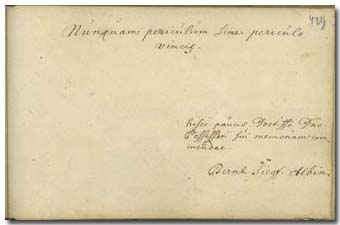
Nunquam periculum sine periculo vincitur.
Hisce paucis Doctiss[im]o D[omi]no Possessori sui memoriam
commendat.
Bernh[ardus] Siegf[ried] Albin[us] |
|
Danger is never won without danger.
With this trifle I recommend myself into the
memory of the erudite owner [of this album]
Bernhard Siegfried Albinus
|
p.
429. [Leiden? May, 1715?]
Albinus, Bernhard Siegfried
(1697-1770), German anatomist,
professor in Leiden
Bernhard
Siegfried Albinus (Albin) was born on February 24, 1697 in
Frankfurt an der Oder, the son of the physician Bernhard Albinus (1653-1721)
and of Susanna
Catharina Rings. He studied with his father and with the
professors Govard Bidloo (1649-1713),
Herman Boerhaave (1668-1738) and Johann Jacob Rau (1668-1719)
in Leiden, then in 1718 he went to Paris to study anatomy and
chirurgy. Following Boerhaave's mechanistic theory, he strived
after getting to know all the structural parts of the body. At the
age of 21 he was already extraordinary professor of anatomy in
Leiden, and he was awarded doctoral degree without defence. After
the death of Rau he followed him in his professor's chair. In
1721, at the death of his father he became ordinary professor of
anatomy and chirurgy, and in 1745 professor of medicine as well.
He led these three chairs until the end of his life. He was a
member of the scientific societies of Leiden, Haarlem and
St.-Petersbourg. He died in Leiden on September 9, 1770. He was
the most important anatomist and professor of medicine of his age,
renewer of descriptive anatomy. Petrus Camper
(1722-1789) criticising his method of description, nevertheless
called him “prince of anatomists”: “anatomicorum princeps magnus Albinus”.
He was the first to demonstrate the connection between the blood
circulation of the mother and that of the fetus. His works were
characterized by accuracy, clarity and rich illustrations. Two of
his works, the Libellus de ossibus corporis
humani (Leiden, 1726) and the Historia musculorum hominis
(Leiden, 1734) were used for generations, even in the 19th
century. He published, together with Boerhaave, the works of Vesalius, Bartholomaeus
Eustachius and Harvey. His best known work is the Tabulae anatomicae sceletti et musculorum
corporis humani, Leiden, 1747, with the gorgeous illustrations
by Jan
Wandelaar (1690-1759). To this work his youngest brother and his
successor in 1770, Friedrich Bernhard Albinus (1715-1778)
published a separate commentary: De natura hominis
libellus. Leiden, 1775.
The younger Albinus did not date his note. He
probably wrote it in Leiden, while still a student, at the same
time when his father, the professor of medicine (p.
105), that is, in May 1715.
• ADB • AlbSchLeid 2 • EncBrit •
Jöcher-Adelung • Meusel • Michaud • MNL • NDB • NNBW IV 22
|

